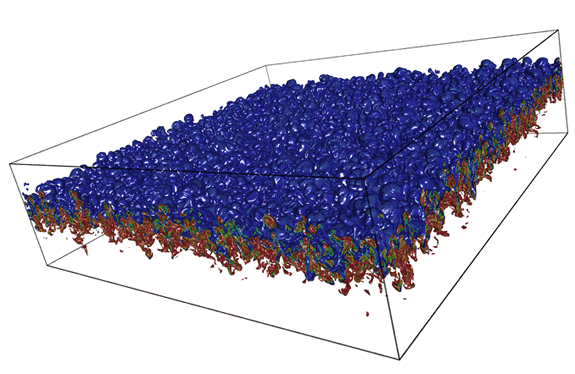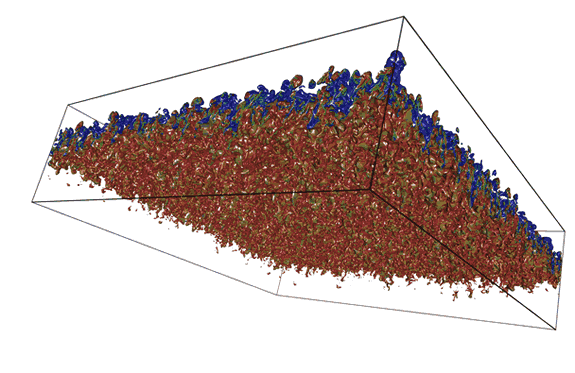Spikes and Bubbles in Turbulent Mixing: High Atwood Number Rayleigh-Taylor Instability
Daniel Livescu (CCS-2/LANL)
Mark R. Petersen (CCS-2/LANL)
Steven L. Martin (Ohio State University)
Patrick S. McCormick (CCS-1/LANL)

The Rayleigh-Taylor instability occurs at the interface between a heavy fluid overlying a light fluid, under a constant acceleration, and is of fundamental importance in a multitude of applications ranging from astrophysics and to ocean and atmosphere dynamics. The flow starts from rest and small perturbations at the interface between the two fluids grow to large sizes, interact nonlinearly, and eventually become turbulent. In many cases, the density ratio between the two fluids is large, e.g. air interpenetrating helium has a density ratio of 7, yet most studies to date address the low density ratio case and no Direct Numerical Simulations (such that all scales of motion are resolved) have been performed for Atwood number, A > 0.5 (corresponding to a density ratio of 3). Previous results at A = 0.5 (Livescu et al, Journal of Turbulence 2009, Livescu and Ristorcelli, Journal of Fluid Mechanics 2007 and 2008, Cabot and Cook, Nature Physics 2006) hint to some startling new physics in high Atwood number Rayleigh-Taylor mixing, for example the asymmetry of the mixing, not seen at small density differences.

The images presented here show the density field obtained from the largest fully resolved instability simulation performed to date: Rayleigh-Taylor instability at A=0.75 (density ratio of 7) on a 2304x4096^2 mesh. The results fully confirm the conjectures made earlier by the authors and are in agreement with previous experiments for the layer growth rate. In particular, the asymmetry of the mixing leads to a tangible alteration of the mixing layer: the formation of "spikes" on the light fluid side and "bubbles" on the heavy fluid side."
Los Alamos National Laboratory is operated by the Los Alamos National Security, LLC for the U.S. Department of Energy NNSA under contract no. DE-AC52-06NA25396. This work was funded in part by the LDRD program at Los Alamos National Laboratory through project number 20090058DR. The simulation was performed on the LLNL ASC Dawn supercomputer, as part of the open science runs.
Reporters and Editors
The images have not been published. Reporters can freely use this image. Credit: Daniel Livescu (CCS-2/LANL), Mark R. Petersen (CCS-2/LANL), Steven L. Martin (Ohio State University), Patrick S. McCormick (CCS-1/LANL)
Please notify Daniel Livescu before using the images.
